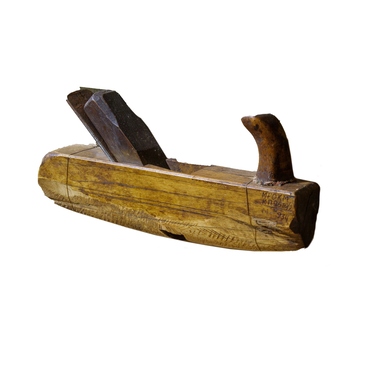The exhibition presets the cooper’s tool, which was made in a village situated in Saransk district, Penza Province. It appeared in the museum’s funds after the expedition trip of the museum staff to the Romodanovsky district in 1970. A local citizen, Maria Gudkova, presented to the researchers a tool called “tightening tool”.
Coopers — craftsmen, who made barrels and other wooden containers — used stretching tools. The tool is a forged iron bracket, movably fixed in a through slot of a wooden handle. Coopers put on metal and wooden chime hoops on the barrel with the help of stretching tool. Chime hoops were the edge, end hoops of the barrel.
Masters hooked the hoop when putting it on a barrel or a tub, and the end of the handle rested against the edge of the woodenware. At first, the barrel carcass was pulled together using a windlass, a rope loop. By pressing the handle, a part of the hoop was pulled over the edge of the staves that make up the walls of the container. Then masters moved the stretching tool along the barrel side and this way drew the rest of the hoop sections on the carcass.
Craftsmen used four hoops for barrels with a capacity of up to 50 liters, for more capacious containers, their number was increased to six. The masters made wooden hoops themselves from young oaks, elms, and bird cherries. The coopers measured the product along circumference, made notches (locks) at the ends to adhere to each other before hooping. The coopers had to buy iron hoops. They were more resistant, but had a serious disadvantage: these hoops painted the barrel with rust under the moisture influence.
On the territory of the Mordovian Region, cooperage began to emerge in the second half of the 17th century with the development of potash production.
Potash is a mixture of potassium and carbonic acid. Usually it is contaminated with various impurities, so it does not have such a pure white color as crushed potassium carbonate. Until the 20th century, potash was one of the most important industrial chemicals in Europe. It was used in the textile and leather industry, in the production of soap and high-quality glass.
Coopers — craftsmen, who made barrels and other wooden containers — used stretching tools. The tool is a forged iron bracket, movably fixed in a through slot of a wooden handle. Coopers put on metal and wooden chime hoops on the barrel with the help of stretching tool. Chime hoops were the edge, end hoops of the barrel.
Masters hooked the hoop when putting it on a barrel or a tub, and the end of the handle rested against the edge of the woodenware. At first, the barrel carcass was pulled together using a windlass, a rope loop. By pressing the handle, a part of the hoop was pulled over the edge of the staves that make up the walls of the container. Then masters moved the stretching tool along the barrel side and this way drew the rest of the hoop sections on the carcass.
Craftsmen used four hoops for barrels with a capacity of up to 50 liters, for more capacious containers, their number was increased to six. The masters made wooden hoops themselves from young oaks, elms, and bird cherries. The coopers measured the product along circumference, made notches (locks) at the ends to adhere to each other before hooping. The coopers had to buy iron hoops. They were more resistant, but had a serious disadvantage: these hoops painted the barrel with rust under the moisture influence.
On the territory of the Mordovian Region, cooperage began to emerge in the second half of the 17th century with the development of potash production.
Potash is a mixture of potassium and carbonic acid. Usually it is contaminated with various impurities, so it does not have such a pure white color as crushed potassium carbonate. Until the 20th century, potash was one of the most important industrial chemicals in Europe. It was used in the textile and leather industry, in the production of soap and high-quality glass.



